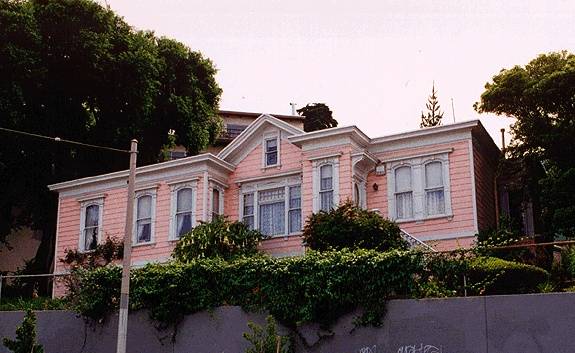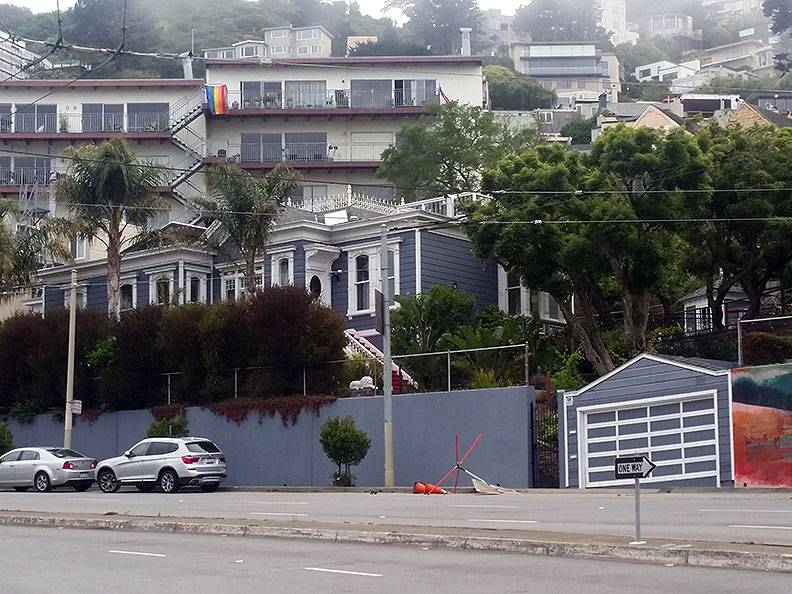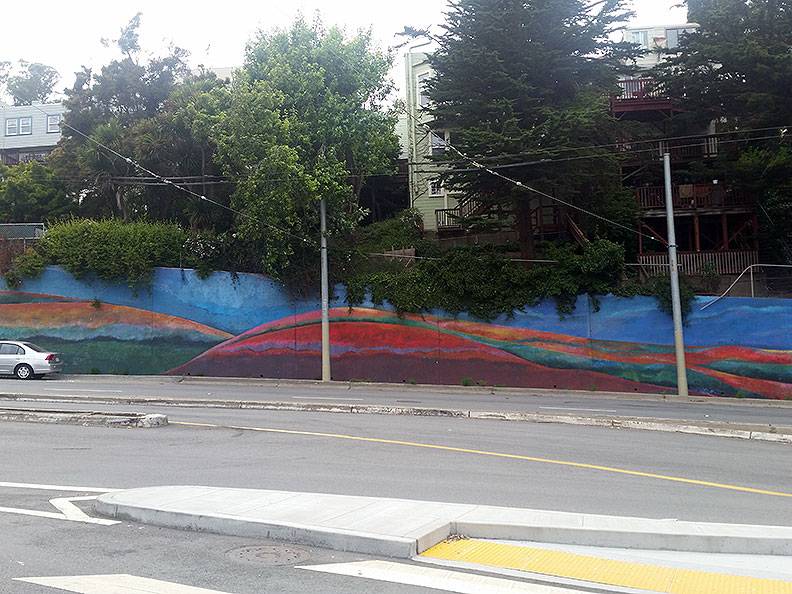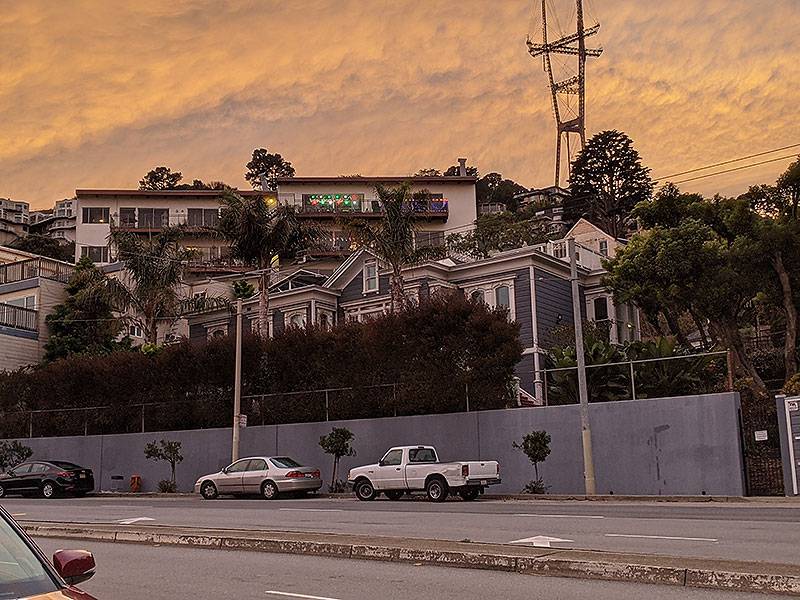Father of Southwest San Francisco Behrend Joost (1845-1917)
Historical Essay
by Mae Silver
1905 view west toward intersection of Falcon (now Market) and Moss Alley (now 19th). Miller-Joost home at the left, Twin Peaks and Tank Hill in upper background.
Photo: OpenSFHistory.org wnp15.1723
In his day, Behrend Joost received two affectionate titles from his neighbors: "Father of South San Francisco" and "Grand Old Man of Twin Peaks." They honored him as a family member in the outside lands, that part of town he loved, lived in and developed. As a contemporary of the other major developers of Rancho San Miguel, some of his business transactions related to them. However, even before Joost's ventures into real estate, he became indirectly involved with Francois L.A. Pioche and Lester L. Robinson. It happened this way.
Miller-Joost House from upper Market Street in the 1990s
Photo: Chris Carlsson
New paint and remodeling, but still the oldest house in the area, adjacent to what was one of the quirkiest open spaces in San Francisco until its recent destruction.
Photo: Chris Carlsson, 2017
Rainbow mural along upper Market just east of the Miller-Joost house.
Photo: Chris Carlsson
The Victorian farmhouse known today as the Miller-Joost House at 3224 Market Street was Joost's family residence. But before that, Adam Miller owned it. Miller ran a milk ranch on Corbett Road. He bought his property from Pioche and Robinson from their subdivision offering in 1867. He built his house and other buildings at 104 Falcon Street, now 3224 Market Street. When Adam Miller's daughter Anna became Behrend Joost's wife, the house became the Miller-Joost residence. Now owned by Dr. Polly Clayborn-Mosby, the Miller-Joost House has historical landmark status and is the oldest house on Twin Peaks.
The story of Behrend Joost's life in San Francisco was a "from rags to riches" fable. Behrend Joost was a farm boy from Germany. He and his four brothers came to San Francisco to find their fortune. At the age of 15, Behrend booked passage to America where two other brothers already lived. Fabian was a goldminer in California when Behrend arrived in April Of 1857. Tonjes, the oldest brother, had a grocery store and Behrend became a salesman in his store. Within two years, he had saved $1000 and a few days before Christmas, 1859, Behrend opened his own grocery store at 11th Street and Mission, a busy toll road.
This young immigrant from Amt Lehe, near Hanover Germany, quickly grasped some important concepts about San Francisco real estate. Each time Joost opened a new store, he bought the building. Most often, he resided in the store building. He invested profits from his grocery business in local real estate. In 1887, Behrend changed his retail merchandise from groceries to hardware. He and Fabian developed a partnership. Then Behrend made a notable shift in business. He became a principal organizer of the California Dredging Company involved in the early stages of building the Panama Canal headed by Ferdinand de Lesseps's Company. After fourteen months of work, Behrend realized a profit of $850,000. He was very fortunate. By 1889, disease, construction problems, and inadequate financing plunged de Lesseps's Company into bankruptcy. Joost's escape from this venture with a profit was quite a feat.
Behrend Joost used that fortune to refocus his career in real estate and railroad building in San Francisco. In 1888, Joost Brothers and Dahler Company were real estate agents with an address at 947 17th Street. On December 16, 1890, Behrend secured a franchise to build San Francisco's first electric railway over the hills. On Wednesday, August 27, 1892, the opening run of San Francisco's first electric railway hosted some 400 guests. It was a festive celebration. In 1893, Joost moved downtown to 326 Montgomery Street where he published the San Francisco Real Estate Guide and directed the San Francisco San Mateo Railway Company and his real estate investments.
The Railway Company operated thirty cars from downtown Market Street to San Mateo county: the route started at Steuart and Market, via Steuart, Harrison, 14th Street, Guerrero, Chenery, San Jose Avenue to the Baden stockyards in San Mateo. Joost apparently had financial problems and sold out to John Spreckels and Brothers who reorganized and added two routes: one to Holy Cross Cemetery, the other connected Guerrero up 18th Street to the Falcon-Clayton Street switch back (now Market/ Clayton), a half block from Joost's residence, to Waller Street at Golden Gate Park. Joost's electric railway had solved the problem of the hills for neighbors. People could quickly move from valley to valley. Now, it was easier for people in the Rancho San Miguel neighborhoods to get downtown. His railroad opened more land for residential development. One cannot know his motives for building his railroad. This sort of business move seemed entirely Victorian when ventures into the unknown were encouraged and were possible. Was it only greed to build a railway to open up more real estate deals? Or did Joost concern himself with enlarging people's lives?
Unlike his other brothers, Behrend had a talent for organizing. Whether it was in Panama, or retail, railroading, or real estate, he had a knack for putting pieces together and turning a profit from it. He became one of the city's heaviest and most successful real estate dealers in the outside lands. At one time or another he was associated with: the Pacific Homestead Association, Market Street Homestead Association (Pioche and Robinson), Noe Garden Union Homestead Association (Pioche and Robinson), South San Francisco I Homestead Association, Bayview Homestead Association, Paul Tract Homestead Association, Clarendon Heights Land Company (owned by Joost), Sunnyside Land Company (owned by Joost). He was also involved with the American Bank and Trust Company, the Sunnyside Construction Company (owned by Joost), and the Potrero Land and Water Company. Joost also owned the Mountain Spring Water Company that had its water origins southeast of his home. Residents in the neighborhood today recall a surface spring at Corbett and Clayton from which water was sold by the bucket or cup. A wooden bridge across Corbett on Clayton made the road muddied by the spring much more passable.
That Mountain Spring water turned "Nobby" Clarke's and Behrend Joost's lives into daily warfare. In the early 1890s, Alfred Clarke bought seventeen acres of land in and around Caselli and Douglass Streets. Clarke's land was downhill from Joost's. The spring in dispute flowed through Joost's property down to Clarke's. Clarke didn't like Joost's water service and started his own. In turn, when Joost extended his water service, he ruined business for both of them. Perhaps this quarrel between two neighbors was the signal that all was not well with Behrend Joost. There were rumors about family disputes. Joost declared in his will he was not treated well by his family. At the time of his death, he was trying to retrieve the property he had earlier transferred to his children. His estate of a mere $20,000 was a small showing for a vigorous business life that involved millions of dollars. On September 24, 1917, the San Francisco Call reported Joost's death by suicide on the front page. According to his son, Joost took poison to escape his poor health. He died in his home, in his own neighborhood. He was 82.
Behrend Joost, a farm boy from Germany, made his way into the hearts of those in the neighborhoods called the "outside lands." He made a living, a fortune in his time, in his own neighborhood. He had visions about land-whether it was selling produce from it, dredging it for the Panama Canal, buying and selling it, traversing it with an electric railway or selling the water that ran through it. He also saw land simply as yard space to plant a weeping willow tree that won him a state prize. This "Grand Old Man of Twin Peaks" gave the suburbs a very valuable railway connection downtown. Behrend Joost opened Rancho San Miguel neighborhoods to yet another important chapter of the city's growth and prosperity.
Miller-Joost house in February, 2020, during a gorgeous sunset.
Photo: Chris Carlsson





